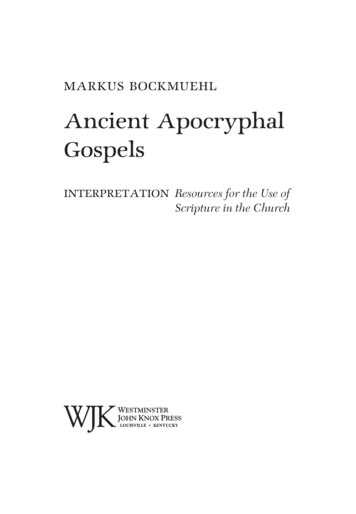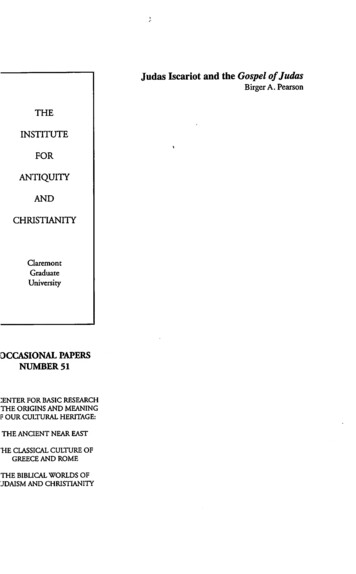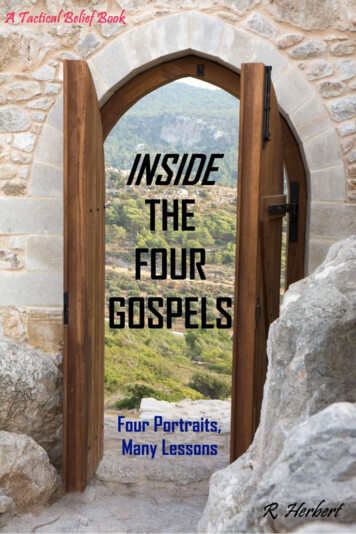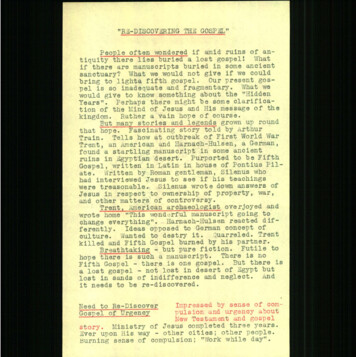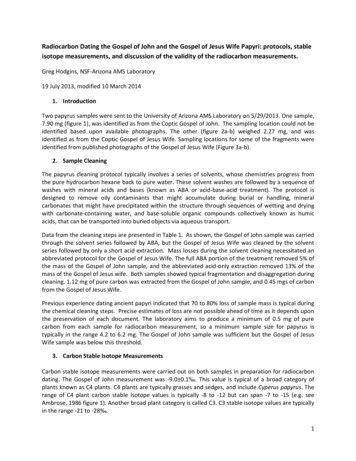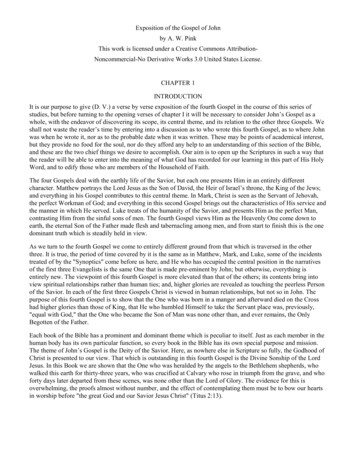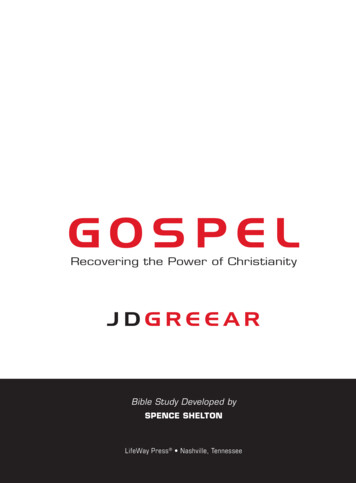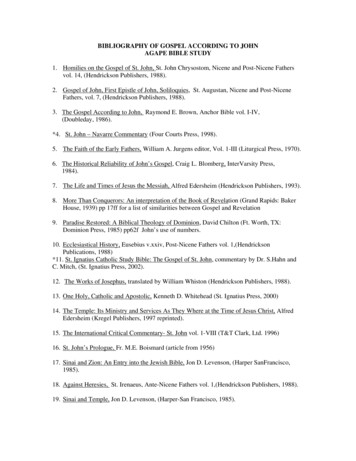
Transcription
BIBLIOGRAPHY OF GOSPEL ACCORDING TO JOHNAGAPE BIBLE STUDY1. Homilies on the Gospel of St. John, St. John Chrysostom, Nicene and Post-Nicene Fathersvol. 14, (Hendrickson Publishers, 1988).2. Gospel of John, First Epistle of John, Soliloquies, St. Augustan, Nicene and Post-NiceneFathers, vol. 7, (Hendrickson Publishers, 1988).3. The Gospel According to John, Raymond E. Brown, Anchor Bible vol. I-IV,(Doubleday, 1986).*4. St. John – Navarre Commentary (Four Courts Press, 1998).5. The Faith of the Early Fathers, William A. Jurgens editor, Vol. 1-III (Liturgical Press, 1970).6. The Historical Reliability of John’s Gospel, Craig L. Blomberg, InterVarsity Press,1984).7. The Life and Times of Jesus the Messiah, Alfred Edersheim (Hendrickson Publishers, 1993).8. More Than Conquerors: An interpretation of the Book of Revelation (Grand Rapids: BakerHouse, 1939) pp 17ff for a list of similarities between Gospel and Revelation9. Paradise Restored: A Biblical Theology of Dominion, David Chilton (Ft. Worth, TX:Dominion Press, 1985) pp62f John’s use of numbers.10. Ecclesiastical History, Eusebius v.xxiv, Post-Nicene Fathers vol. 1,(HendricksonPublications, 1988)*11. St. Ignatius Catholic Study Bible: The Gospel of St. John, commentary by Dr. S.Hahn andC. Mitch, (St. Ignatius Press, 2002).12. The Works of Josephus, translated by William Whiston (Hendrickson Publishers, 1988).13. One Holy, Catholic and Apostolic, Kenneth D. Whitehead (St. Ignatius Press, 2000)14. The Temple: Its Ministry and Services As They Where at the Time of Jesus Christ, AlfredEdersheim (Kregel Publishers, 1997 reprinted).15. The International Critical Commentary- St. John vol. 1-VIII (T&T Clark, Ltd. 1996)16. St. John’s Prologue, Fr. M.E. Boismard (article from 1956)17. Sinai and Zion: An Entry into the Jewish Bible, Jon D. Levenson, (Harper SanFrancisco,1985).18. Against Heresies, St. Irenaeus, Ante-Nicene Fathers vol. 1,(Hendrickson Publishers, 1988).19. Sinai and Temple, Jon D. Levenson, (Harper-San Francisco, 1985).
20. On the Incarnation, St. Athanasius. Translated and edited by Sister Penelope Lawson, NewYork: Macmillan publishing company, 1946.Articles:Marriage feast at Cana: Fr. Joseph Grassie, Mary Mother and Disciple, page 86.Jon Levenson, article The Temple and the World, Journal of Religion vol. 64, 1984 pp275-298.* recommended to the class as a companion book to the course.
OUTLINE FOR THE GOSPEL ACCORDING TO JOHNCREATIONBOOK 1 – THE PROLOGUE 1:1-1:18I. THE DIETY OF CHRISTII. THE PREINCARNATION OF CHRISTA. He is the foundation of all lifeB. He is the lightC. The darkness cannot overcome HimIII. THE FORERUNNER OF CHRISTIV. THE REJECTION OF CHRISTV. THE ACCEPTANCE OF CHRISTVI. THE INCAARNATION OF CHRISTA. The Word becomes flesh (v. 14)B. John prophesizes Christ 1
BOOK 2 – THE PRESENTATION OF THE SON OF GOD 1:19-4:54JORDAN RIVER – JUDEATHE FIRST WEEKI. THE PRESENTATION OF THE SON OF GOD1:19-34DAY 1A. John’s witness to the Old Covenant authority1:19-28DAY 2B. John’s witness at Christ’s baptism1:29-34II. THE PRESENTATION OF THE SON OF GOD TO JOHN’S 1:35-51DISCIPLESDAY 3A. The two disciples talk with Jesus1:35-39B. Andrew and Peter talk with Jesus1:40-42DAY 4C. Philip and Nathaniel talk with Jesus1:43-51III. THE PRESENTATION OF THE SON OF GOD IN THE2:1-12GALILEEDAY 7 GALILEE – Cana (3 days later)“A. The wedding at Cana2:1-11“1. The Woman and her Seed2:1-5“2. SIGN #1 (Old Covenant vs. New Covenant) 2:5-10“3. The Disciples believe2:11A fewGALILEE –CaperanumdaysB. Jesus, Mary, His kinsmen and His Disciples2:12laterJUDEA JERUSALEM (Spring)P #1IV. THE PRESENTATION OF THE SON OF GOD IN JUDEA 2:13-3:36AA. Jesus cleanses the Temple –2:13-23SThe prediction of the 3-day signSB. Jesus witnesses to Nicodemus3:1-21OC. John the Baptist witnesses concerning Jesus3:22-36VERJesus in SAMARIAV. THE PRESENTATION OF THE SON OF GOD IN4:1-42SAMARIAA. Jesus and the Samaritan Woman4:1-26B. Jesus teaches His Disciples4:27-38C. Jesus witnesses to Samaria4:39-42Jesus in the GALILEEVI. THE PRESENTATION OF THE SON OF GOD IN THE4:43-54GALILEEA. Christ is received by the Galileans4:43-45Cana and CapernaumB. SIGN #2: Jesus heals the royal official’s son4:46-542
BOOK 3 – OPPOSITION TO THE SON OF GOD 5:1-12:50JUDEA - JERUSALEMUFI. OPPOSITION IN JERUSALEM5:1-47NE(pool of Bethesda, Jerusalem)NAA. SIGN #3 – Jesus heals the paralytic man5:1-9ASB. Jesus’ homily/ Jews of Jerusalem reject Christ5:10-47MT1. Greater than John the Baptist5:31-40E2. Unbelief of the Jews5: 41-47DJesus in the GALILEE just before the Feast of PASSOVER#2Spring6:1-71justII. OPPOSITION IN THE GALILEEbeforeP OA. SIGN #4 – Christ feeds 5,000 men6:1-14A VB. Christ walks on the water6:15-21(the hidden sign only revealed to the Apostles)S EC. The Bread of Life; #1: I AM the Bread of Life6:22-71S R(6:35, 41, 48, 51). The first of the 7 “I AM” discourses#2Jesus in JUDEA –JERUSALEM (Fall)TIII. OPPOSITION IN JERUSALEM7:1-10:21AA. Feast of Tabernacles: Jesus leaves the Galilee to 7:1-13Btravel to JerusalemEB. The Middle of the Feast7:14-36RC. The Last Day of the Feast7:37-53ND. After the Feast8:1-10:21A1. The Adulteress8:1-11C2. The Light of the World; #2: I AM the8:12-59LLight of the WorldE3. SIGN #5 Healing of the man born blind 9:1-40S4. The Good Shepherd; # 3: I AM the Door 10:1-21of the sheep; # 4: I AM the Good ShepherdWinter:IV. THE OPPOSITION CONTINUES IN JERUSALEM10:22-42Feast ofduring the Feast of Dedication (Hanukkah)DedicationJesus in BETHANY (near Jerusalem)V. THE OPPOSITION AT BETHANY11:1– 2:11A. SIGN #6: Jesus raised Lazarus from the dead;11:1-44#5: I AM the Resurrection and the LifeSpringB. The Pharisees plan to kill Jesus11:45-57(day 6Jesus in BETHANY in JUDEAbefore theTHE LAST WEEK:Passover)6 days before the PASSOVER FEAST (John 12:1-11)C. Jesus and the Apostles stay the night at Bethany 12:1-113
(day 5before)Nisan 101. Mary of Bethany anoints Jesus2. Crowds gather to see Jesus and LazarusVI. THE FINAL OPPOSITION AT JERUSALEMA. The King of Kings enters Jerusalem, PalmSundayB. “The whole world has come after Him!”12:3-812:9-1112:12-2212:12-1512:16-19BOOK 4 – THE PREPARATION OF THE DISCIPLESBY THE SON OF GOD 12:23-17:26Just before PASSOVER #3THE LAST WEEK (first day of Passover is always Nisan 14)(days4 – 2)I. THE MESSIAH TEACHES IN THE TEMPLE:12:20-50Nisan 11A. “The hour has come!”12:20-3613B. The unbelief of the Jews12:37-50II. THE PREPARATION IN THE UPPER ROOM – Day #1 of 13:1-14:31(day 1:the thirdPassover Week /the day of the sacrifice Thursday daytimePassover and the sacrificial meal that night at sundown Friday, Nisanof Jesus’ the 15thministry15 Nisan: Upper Room NightUA. Jesus and the ritual of washing the Apostles’ feet – the13:1-20NPassover feast & first day of the Feast of Unleavened BreadLB. Jesus announces His betrayal13:21-30EC. Jesus’ last instructions to His Apostles; #6: I AM13:31A14:31the Way, the Truth, and the LifethVIII. THE FINAL INSTRUCTIONS –Nisan the 1515:1-17:26ENA. Jesus instructs the Apostles; #7: I AM the True15:1-16:33VineBB. Jesus prepares for His crucifixion in His High17:1-26RPriestly prayer to the FatherEADNote: the Jewish day began at sundown therefore the night of the PassoverFeast is already Friday Nisan 15 according to the Jewish Calendar and the7 DAYS first day of the Feast of Unleavened Bread.LONG4
BOOK 5 – THE CRUCIFIXION AND RESURRECTION OFTHE SON OF GOD 18:1-21:25Night(Nisan15th)cont.I. THE REJECTION OF THE SON OF GODA. The arrest of JesusB. The trials of JesusPredawn1. SanhedrindawnFridayMorning2. Roman governor3. Herod 16Lk 23:7-12Returned to Roman governorFcEoA nSt.TFriday(3 PM9th hour)II. THE CRUCIFIXION OF THE SON OF GODA. Jesus’ crucifixionB. Pilate’s inscriptionC. The Roman soldiers cast lotsD. The gift of Mary to the ChurchE. The Last Cup and His last wordsF. Christ gives up His Spirit19:17-3719:17, 1819:19-2219:23-2519:25-2719:28-2919:30III. THE BURIAL OF THE SON OF GOD19:3121:2520:1-10(3 dayslater)THENEWIV. THE RESURRECTION OF THE SON OF GOD –The Feastof Firstfruits Sunday (see Leviticus 23:23:9-11) The 7th SignV. THE APPEARANCE OF THE SON OF GODCA. to Mary MagdaleneB. to 10 ApostlesC. to 11 ApostlesA few days later on the Sea of GalileeD. to 7 ApostlesE. Jesus’ commission to Simon/Peter21:1-1421:15-23VI. CONCLUSION21:24, 25REATION20:1121:2520:1-1820:19-2520:26-305
YAHWEH’S EIGHT COVENANTSBut Yahweh’s faithful love for those who fear him is from eternity and for ever; and hissaving justice to their children’s children; as long as they keep his covenant, andcarefully obey his precepts. Palms 103:17-18COVENANT1. Adam-fertility-dominion over the earth2. Noah and the earth-The earth will never bedestroyed by flood watersagain (water will become asign of salvation)3. Abraham 3-fold,(continues with Isaac, Jacob& descendants)-land, nation (descendants)& world wide blessing4. Moses & Israel-Sinai Covenantestablishing divine liturgy& covenant sacrements5. Aaron & Sons-perpetual ministerialpriesthood of the LevitesSIGNTree of LifeSCRIPTUREGenesis 1:28-30; Genesis2:15-17; Hosea 6:7But they, like Adam,transgressed the covenant;there they betrayed Me.(Ho 6:7)Genesis 6:18; 9:9-17;Sirach 44:17-18.RainbowCircumcisionOn the 8th dayArk of the CovenantTabernacle10 CommandmentsSaltGenesis 12:3; 15:1-18;17: 1-27; 18:18 & 22:13-18;26:3-5; 28:10-14; Exodus2:24; Psalm 105:8-11;Sirach 44:19-20Exodus 19-24; 34:10, 27,28; Deuteronomy 5:2-3;29:12.Exodus 40:15; Leviticus2:13; Numbers 18:19;Sirach 45:7; Jeremiah33:21.Numbers 25:11-15; Sirach45:24.6. Phinehas-perpetual priesthood inSeamless robe & miterCovenant of Peace(prefigures Christ)7. David & descendants2 Samuel 7:11-17; 23:5;-dynasty and throne foreverThrone/ Temple2 Chronicles 31:5; Psalmsecure89:3-4; Sirach 45:25.8. Jesus (Yah’shua Isaiah 55:3; JeremiahYahweh saves or I save)31:31-34; Matthew 26:28;also written Yehosua The Cross, the true “Tree of Mark 14:24; Luke 22:20; 1Joshua. He is theLife”Corinthians 11:25; Hebrewsfulfillment of all the12:24.covenantal promisesMichal Hunt copyright 1998, revised July, 2006www.AgapeBibleStudy.com
* There are more Scripture passages referring to Yahweh’s 8 Covenants thanthose listed in the chart. Some additional Scripture references for the various covenantsare listed below: Adam: Most English Bible translations include in their footnotes that Hosea 6:7can be translated “They have broken the covenant like Adam ” The word“adam” can mean the first man “Adam”, or “man”, or even “ground” or “earth”].The Jewish Tanach translates Hoses 6:6-7: For I desire kindness, not sacrifice;and knowledge of God more than burnt-offerings. But they, like Adam,transgressed the covenant; there they betrayed Me. In Genesis 6:18: the Hebrewword “quwm” can also be translated “restore” , “continue”, or “maintain” whichis why most scholars assume the first covenant was established with Adam andthen continued with Noah. If there was no covenant there would be no covenantobligations or violations of the covenant. Noah: Genesis 6:18; 9:9, 11, 12 (twice), 13, 15, 16, 17; Sirach 44:17-18; Isaiah24:5 Abraham (and descendants): Genesis 15:18; 17:2, 4, 7 (twice), 9, 10 (twice);17:11, 13 (twice), 14, 19 (twice), 22:13-18; 28:13-14; 31:44; Exodus 2:24; 6:2-5;Leviticus 26: 42-45; 2 Kings 13:23; 17:15, 35, 38; 18:12; 23:2, 3 (three times),21; 1 Chronicles 16:15-17; Sirach 44:19-23; Psalm 105:9; Acts 3:25; 7:8. Mosaic Covenant with Israel: Exodus 19:5; 24:7, 8; 31:16; 34:10, 27, 28;Leviticus 24:8-9; 26:9, 15, 25, 42 (3 times), 44, 45; Deuteronomy 4:13, 23, 31;5:2-3; 7:9,12; 8:18; 9:9, 11, 15; 17:2; 29:1, 9, 12 (twice), 14, 21, 25 (twice);31:16, 20; 33:9; Joshua 7:11, 15; 23:16; Judges 2:1, 20; 1 Kings 8:9, 21, 23;19:10-11; 2 Chronicles 6:11, 14; 34:30, 31 (twice), 32; Psalm 105:8-11; 106:45;Isaiah 42:6; 54:10. Aaron and sons: Exodus 40:15; Leviticus 2:13; 18:19; Numbers 18:19; Nehemiah13:25; Sirach 45:7, 15; Jeremiah 33:21; Malachi 2:4-9. Phinehas: Numbers 25:11-13; Sirach 45:24; Psalm 106:30-31 (an example ofrighteousness for the ages). David: 2 Samuel 7:11-17; 23:5; 23:5; 1 Kings 2:4; 11:9-20; Sirach 45:25; 47:11; 2Chronicles 7:18; 13:5; 21:7; Psalm 89:3, 28, 34, 132: 1-18; Psalm 132; Jeremiah33:21; Acts 2:30. Jesus: Isaiah 59:20-21 [Romans 11:26-27]; Matthew 26:28; Mark 14:24; Luke22:20; 1 Corinthians 11:25; 2 Corinthians 3:6-14; Galatians 4:24; Hebrews 7:22;8:6-13; 9:15-20; 10:14-29 (quoting Jeremiah 31:31-34); 12:24; 13:20.Covenants involve oath-swearing: Genesis 21:23-24 (Abimelech and Abraham); 22:16;Exodus 17:16; Deut. 6:13; 7:7-11; 13:18-19 (17-18); 29:11-14 (12-15); Joshua 2:17
(Rahab’s covenant with Israelite soldiers); 1 Sam 20:17 (covenant between Jonathan andDavid); 24:21-22 (David and Saul); 2 Sam. 3:9; 2 Chronicles 15:12-15; Nehemiah 10:30(29); Psalm 89:3; 105:8-9; 110:4; Sir. 44:21 (22); Luke 1:73; Acts 2:30; Hebrews 6:13;Latin word sacramentum oathConditional covenants: (“if” cause) Blessings for obedience; curses for disobedience Adamic: blessings Gen. 1:28-30; conditions: Gen. 2:15-17; curse: Gen. 3:15-19 Abrahamic: conditional for Abraham’s descendants: Gen 17:19-22 (only throughIsaac) Davidic: conditional for descendants 1 Kings 2:3-4; 1 Kings 2:4; 11:11-20 Sinai: Deut. 13:18-19; Covenant treaty book of Deut.; covenant lawsuit inHosea; covenant blessings Deut. 28:1-14; covenant curses 28:25-69. New covenant: (Covenant treaty: Book of Revelation covenant lawsuit);Blessings Matt. 5:1-12 & curses Matt. 23:13-30; 25:31-46. Conditionalcovenant with baptized believers.Non-conditional covenants: Noahide: Sir 44:17-18 Abrahamic: Gen 12:1-3 Aaronic: for lineal descent but conditional on individuals: Sir 44:7 (8), 15 (19) Phinehas’ covenant of peace: Num 25:13; Sir 45:24; by linear descent; samerestrictions as above on individuals Davidic: 2 Sam. 7:14; 1Ch 17:14; 2 Ch 3:1; Sir. 45:25 (by linear descent); 47:11(13); restrictions on individuals New Covenant: Hebrews 7:21-28 (God’s covenant with Christ is non-conditionaland eternal)
THE SEVEN SACRED ANNUAL FEASTS OF THE OLDCOVENANT: The Feasts of RemembranceYahweh said to Moses, ‘Speak to the Israelites and say to them:‘These are my appointed feasts, the appointed feasts of Yahweh, whichyou are to proclaim as sacred assemblies.’ Leviticus 23:1-2Then never let anyone criticize you for what you eat or drink, or about observance ofannual festivals, [.]. These are only a shadow of what was coming; the reality is thebody of Christ. Colossians 2:16-17* Pilgrim feasts: Exodus 23:14-17; 34:18-23; Deuteronomy 16:1-16SACRED FEASTOLDOLDDESCRIPTIONTESTAMENTTESTAMENT /Old Testament andSCRIPTUREMODERN TIMEapplication NewREFERENCETestamentthPASSOVER (begins Ex 12:1-4; Lev14 Aviv (Nisan)Old Testament:the liturgical year)23:5;Slaying and eating aMar./Apr.(PESACH)Num 9:1-14; Numlamb or kid,remembering-Signified the28:16Israel’s deliveranceRedemption ofDt 16:1-3, 4-7;from death, the 10thIsraelMt 26:17; Mk14:12-26;plague.Jn 2:13; Jn 11:55;N.T. last legitimate1 Cor 5:7; HebOld Covenant11:28Passover sacrifice*UNLEVENEDEx 12:15-20; 39; Ex 15-21 Aviv (Nisan) Old Testament:Mar./Apr.BREAD13:3-10; Ex 23:15;Eating the Passover(HAGEx 34:18; Lev 23:6- 7 day feastsacrifice in aHAMATZOT)8; Num 28:17-25;sacrificial meal.-Signified theDt 16:3, 4, 8; MkThis feast lasted 7Sanctification of the 14:1,12; Act 12:3;days (8 if Passover1 Cor 5:6-8Israelis counted) in whicheating bread withyeast (the symbol ofsin) is forbidden.Remembering howYahweh redeemedIsrael out of Egyptin haste and thatthey are called to bea "holy people".Making designateddaily offerings.N.T. The LastSupper/firstEucharistic sacrificeand the Crucifixion1
FIRSTFRUITS(YOMHABIKKURIM)This feast is nolonger observed inRabbinic Judaism(only the“firstfruits” of thewheat harvest at theFeast of Weeks isobserved today)-SignifiedResurrection ofIsrael as a freepeople*WEEKS(PENTECOST 50thday in Greek)(SHAVUOT orHAGHASHAVUOT)also known asFEAST OF THEHARVEST (HAGHAKATZIR)-Signified theOrigination of Israelas the Covenantpeople Of YahwehTRUMPETS(ROSHHASHANA)beginning of thecivil year.-Signified thecalling Israel tojudgmentEx 23:19; 34:26;Lev 23:9-14; Deut.26:5,9-10;Matt 28:1;Mk 16:1-2;Lk 24:1; Jn 1:20;Ro 8:23; 1 Cor15:20-23The day after thefirst Sabbath afterPassover (Lev.23:11) SundayAviv March/AprilEx 23:16; 34:22a;Lev 23:15-21; Num28:26-31; Dt 16:912;Act 2:1-4; 20:16;1 Cor 16:8SivanMay/June 50 daysafter Firstfruits ona SundayTHE LONG SUMMER HARVESTLev 23:23-25; Num 1 Tishri29:1-6;Sept/Oct2Sam 6:15; 1 Cor.15:52; 1 Thes. 4-16Old Testament:Presenting a sheafof the first barleyharvest as a waveoffering; making aburnt offering and agrain offering.Recognizing theredemption of thefirst-born in Egyptand recognizingGod’s bounty in thePromised Land.N.T. ResurrectionSundayOld Testament: Afestival of joy;mandatory andvoluntary offeringsincluding thefirstfruits of thewheat harvest.Recalling the givingof the Law at Sinai50 days aftercrossing the RedSea andthankfulness for theLord’s blessings andbirth of the O.T.Church.N.T. birth of NewCovenant ChurchOld Testament:Ingathering of thenation of Israel. Asacred assembly anda day of restcommemorated withtrumpet blasts andsacrifices. Israelpresents itself beforethe Lord for his2
favor.N.T. The SecondComing of Christ?DAY OFLev 16:1-34; 23:26- 10 TishriOld Testament: AATONEMENT32; Num 29:7-11;Sept/Octday of rest, fasting(YOM KIPUR)Ro 3:24-26; Heband sacrifices of-Signified the9:7; 10:3, 30-31;atonement forAtonement of the10:19-22; Act 27:9;priests and peopleCovenant people2Ptr 3:7; Rev 17:4and atonement forthe tabernacle and& 20:12altar. Cleansepeople and priestsand people fromtheir sins and purifythe Holy Place inthe Temple.N.T. The GreatJudgment ?*TABERNACLESEx 23:16b; 34:22b; 15-22 TishriOld Testament: Aalso called FEASTLev 23:33-38; 39Sept/Octweek of celebration8 day feastOF SHELTERS OR 43;for the fruit harvestNum 29:12-34; Dt(grapes & olives);BOOTHS(SUKKOTH)16:13-15; 1 Kingsliving in booths and-Signified God’s8:3 & 65; 2 Chr 7:1;offering sacrifices.Zec 14:16-19;presence with HisMemorializes theJn 7:2; Mt24:35; 2Covenant people;giving of thePt 3:7, 10 &13; Revlooked forward toTabernacle andthe coming of the21:1giving thanks for theMessiahproductivity of theland.NT Creation ofthe new heaven &earth?* The 3 pilgrim Feasts: every Israelite male, 13 years or older, must present himself toYahweh three times a year at the Temple in Jerusalem at the Feast of Unleavened Bread(the 7 day feast following the Passover sacrifice), the Feast of Weeks (Pentecost), and atthe Feast of Tabernacles (Booths); see Exodus 23:14-17; 34:18-23; Deuteronomy 16:16& 2 Chronicles 8:13. The first three feasts: Passover (which begins the liturgical year),the Feast Unleavened Bread and the Feast of Firstfruits all fall in the same month withinan 8 day period. The last three feasts: the Feast of Trumpets, the Day of Atonement andthe Feast of Tabernacles (which ends the liturgical year), also falls within the samemonth, with the Feast of Tabernacles covering an 8-day period. If the 7 Sacred Feasts area blueprint for God’s plan of salvation then we are presently in the period of “the longsummer harvest”, and the laborers in God’s vineyard are gathering souls into God’sstorehouse of heaven. Colossians 2:16-17: Then never let anyone criticize you for what3
you eat or drink, or about observance of annual festivals, New Moons or Sabbaths.These are only a shadow of what was coming: the reality is the body of Christ.ADDITIONAL SACRED FEASTSWeekly Feast of the Sabbath: The Sabbath is the 7th day of the week, commemoratingthe 7th day of Creation when God “rested” and was set aside as a special day of rest forthe people to worship and commune with God. It was the only day of the week that wasnamed. The Sabbath obligation was first announced in Exodus 16:23-29 in thewilderness on the way to Sinai and was associated with the event of the giving of themanna, which prefigured the Most Holy Eucharist. Other references to this obligation arerepeated in Exodus 20:8-11 (10 Commandments); 31:13-16 (repeated after the sin of theGolden Calf); 35:2-3; Leviticus 23:3; and numerous references throughout the Old andNew Testaments. Sacrifices: The 2 the daily Tamid lambs were doubled (see Numbers28:4-10) and were accompanied by the prescribed wheat cake and wine libation.Periodic Feasts (monthly and holy year feasts): New Moon Feasts: A calendar feast which marked the beginning of each lunarmonth, celebrated with sacrifices and feasting. The official calendar of thecovenant people was a lunar calendar and was designated by a religious orliturgical calendar which began in the spring with the month of Nisan or the civilcalendar which began in the month of Tishri in the early fall. All religious feastswere commanded to be determined by the lunar calendar, even in Jesus’ timewhen it had been determined that the solar calendar was more accurate. Inaddition to the daily Tamid, sacrifices included a goat offered as a sacrifice for sinalong with its accompanying wine libation. Also offered for each New Moonsacrifice were: 2 young bulls, 1 ram and 7 yearling lambs without blemish. Agrain offering accompanied each sacrifice: for a bull three tenths of an ephah offine flour mixed with oil; for each ram, two-tenths of fine flour mixed with iol; foreach lamb one-tenth of fine flour mixed with oil. A libation of half a hin of wineaccompanied the sacrifice fro a bull, one-third of a hin for a ram and one-quarterof a hin for a lamb. Numbers 10:10; 28:11-15; 1 Samuel 20:18; 1 Chronicles23:31; 2 Chronicles 4:8; 8:13; 31:3; Ezra 3:5; Nehemiah 10:33; Isaiah 1:13-14;Ezekiel 45:17; 46:3; Hosea 2:11, 13; Amos 8:5; Colossians 2:16. Sabbath Year Feasts: Every 7th year was designated a Sabbath year of the Lordin which the land “rested.” The obligations for the Sabbath year are found inExodus 23:10-11; Leviticus 25:1-7; 18-22; and Deuteronomy 15:1-11: the landmust be “at rest” and cannot be sown nor can vines be pruned for a year. Thisholy year feast reminded the people that the land belonged to Yahweh. Inaddition to the rest for the land, all Israelites held as slaves were released frombondage in the 7th year and debts were forgiven; although there is some confusionas to whether this release from bondage was always in the Sabbath year or in the7th year from when the Israelite was placed in bondage [also see Nehemiah10:32].4
Jubilee Feasts: Scholars do not agree on how the date of this feast wasdetermined, whether the 49th or 50th year. For me the Biblical account is clear:counting 7 weeks of years, or 49 years from the last Sabbath year, on the changeof the civil year in the fall during the Feast Trumpets the 49th year becomes the 7thSabbath year. Then, 10 days after the New Year celebrated on the Feast ofTrumpets, the 50th year is proclaimed on the Feast of Atonement and is celebratedas a the beginning of the year long Jubilee. This arrangement allowed the Jubileeyear to fall on a Sabbath year and helped to adjust the shorter lunar calendar;otherwise there would be two continuous years of no sowing of the fields and noharvest. This feast provided a holy year of liberation in which the observances ofthe Sabbath year were enforced in addition to the return of the land to its originaltribal owner. This holy feast allowed the Israelites to show the same mercy toeach other that Yahweh had shown to them in the event of the Exodus: captiveswere liberated, debts were forgiven, and Yahweh’s land was “at rest” to be givento the covenant people again the next year. This holy year observance assured thatsocial justice as maintained among the covenant people. Jesus declared a divineJubilee in the first year of His ministry when He quoted from Isaiah 61:1-2. Onlya king of Israel or a High Priest could proclaim a Jubilee year. Jesus announcedHe was the Messianic Davidic heir when He proclaimed a divine Jubilee in Luke4:16-22 [see Leviticus 25:9-52; 27:17-25; Numbers 36:2-4]. Both the 7 yearlySabbath Year Feast and the Jubilee Feasts were dropped by the covenant peoplesoon after taking possession of the Promised Land. Greed and a lack of socialconscience led to the failure to observe these feasts. It was for this reason thatYahweh commended a 70 year exile for Judah to atone for the 490 years of failureto keep the Sabbath Year Feasts. The people owed Yahweh 70 Sabbath years andso the land lay fallow for 70 years before the return from exile. There is noevidence that the Babylonians brought any other group of people into the HolyLand to occupy the land in those 70 years.National Feasts inaugurated by the people and not by Yahweh: Purim (Adar February/March), which celebrates the salvation of the Jews fromgentile persecution in the Book of Esther (Esther 9:18-32). Hanukkah (or Chanukah), celebrated in the month of Kislev (December), thefeast of the rededication of the Temple in Jerusalem described in the Book ofMaccabees, are not festivals ordained by God but are instead festivals proclaimedby the people to celebrate an historical event which demonstrated God’s divineintervention and protection of the Covenant people. Jesus observed the Feast ofHanukkah in John 10:22.Please note that sometime shortly after the resurrection of Christ the Jewish religiousauthority adjusted the dates of the annual Feast of Firstfruits and the next feast which wascelebrated 50 days from Firstfruits, the Feast of Pentecost. They began to celebrate theFeast of Firstfruits on the day after the Feast of Unleavened Bread, on the 16th of Nisanso that feast would not be fulfilled in Jesus’ Resurrection from the dead. This meant thatfrom that time on Firstfruits and Pentecost would no longer fall annually on a Sunday.5
The “great Sabbath” of Passover week was also then considered to be the week prior tothe week long feast instead of in the midst of that holy week.However, the Karaite sect of Judaism, which claims descent from the Sadducees,continues to celebrate Firstfruits on the day after the first Sabbath of Passover week, on aSunday, and Pentecost on a Sunday 50 days later just as commanded in Leviticus 23:11.The Karaites are also the only Jews who continue to celebrate the Feast of Firstfruits.Both Orthodox and Reform Jews count Pentecost as 50 days from the 16th of Nisan. Forverification of this change see Flavius Josephus, Antiquities of the Jews 13.8.4 (252)where this first century AD Jewish historian and former Old Covenant Priest writes:“And truly he did not speak falsely in saying so; for the festival, which we call Pentecost,did then fall out to be the next day to the Sabbath ” Josephus offers evidence that thefestival of Pentecost used to always fall on a Sunday, the day next to the Sabbath whichwas Saturday. The feast of Pentecost was determined by counting 7 times 7 weeks fromthe Feast of Firstfruits and the 50th day would then be the Feast of Pentecost. Josephus’statement means that Firstfruits also used to be celebrated on a Sunday [see Leviticus23:11], foreshadowing God’s plan that the Christ should be resurrected on the Feast ofFirstfruits on a Sunday and that the birth of the New Covenant Church would be on theSunday of the Feast of Pentecost!Michal Hunt copyright 1991revised 1997, 2006, July 2007.6
BIBLIOGRAPHY OF GOSPEL ACCORDING TO JOHN AGAPE BIBLE STUDY 1. Homilies on the Gospel of St. John, St. John Chrysostom, Nicene and Post-Nicene Fathers vol. 14, (Hendrickson Publishers, 1988). . *11. St. Ignatius Catholic Study Bible: The Gospel of St. John, commentary by Dr. S.Hahn and C. Mitch, (St. Ignatius Press, 2002). 12. The Works of .


